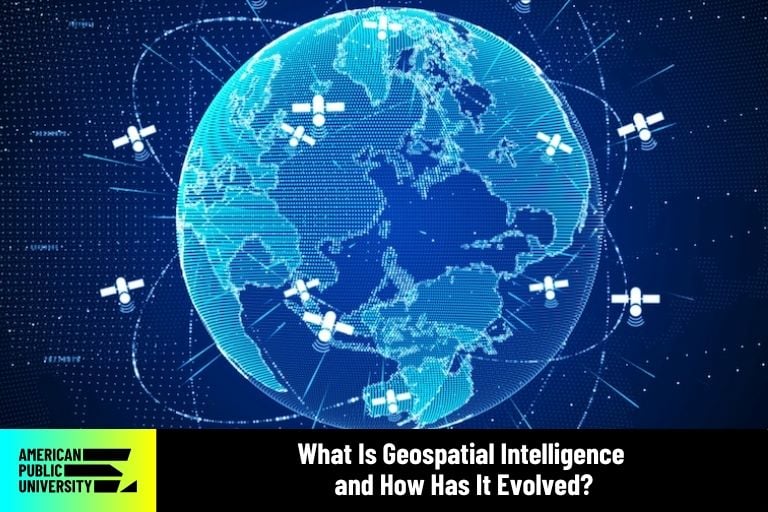By Staff Writer | 04/01/2025

Throughout history, humans have used geospatial information – data regarding specific geographic locations – for everything from epidemiology research to counterterrorism operations. In fact, applications for geospatial intelligence (GEOINT) will likely continue to take many forms as new technologies emerge.
What Is Geospatial Intelligence?
Like the name suggests, GEOINT draws from information about geographic locations. As you might expect, geospatial intelligence is integral to military operations. Still, you may be surprised to learn that the private sector also makes substantial contributions to the GEOINT tradecraft.
How the Intelligence Community Defines ‘Geospatial Intelligence’
The U.S. Intelligence Community (IC) consists of 18 organizations that collect, analyze, and safeguard data to protect national security. Among these organizations is the National Geospatial-Intelligence Agency (NGA), who offers this definition of geospatial intelligence:
“Geospatial intelligence, or GEOINT, is the exploitation and analysis of imagery and geospatial information to describe, assess, and visually depict physical features and geographically referenced activities on the Earth. GEOINT consists of imagery, imagery intelligence, and geospatial information.”
Geospatial Intelligence in Simple Terms
“GEOINT is the layering of data, along with precision geolocation and timing, on a map or image to understand human activity or events,” says Dr. James Burch, the Department Chair for American Public University’s Intelligence Studies program.
Dr. Burch, a U.S. Navy veteran who served as a Naval cryptologist intelligence professional for over 20 years, adds: “GEOINT enables military forces to plan combat missions, locate adversary forces, and gain a better understanding into enemy intentions.”
He also notes that geospatial intelligence has non-military applications as well. For example, first responders may apply GEOINT to direct their activities in the wake of a natural disaster or other contingency.
GEOINT can help firefighters locate rural wildfires and disaster relief teams may also use GEOINT to establish supply locations after a hurricane, according to Dr. Burch.
The Difference Between Geospatial Data and Geospatial Intelligence
As the Geospatial Data Act of 2018 (GDA) says, geospatial data represents the distinct features of a given location. It may be gathered “by identifying the geographic location and characteristics of natural or constructed features and boundaries on the Earth,” according to the GDA.
This spatial data forms the basis of geospatial intelligence. In other words, intelligence professionals analyze geospatial data to produce meaningful insights in the form of GEOINT.
Geospatial intelligence professionals may also use the term “GEOINT data” to refer to the information they gather.
How Have the Public and Private Sectors Contributed to Geospatial Intelligence?
The geospatial intelligence tradecraft employs cutting-edge technology to collect information about human geography. This technology – and the processes through which GEOINT professionals analyze geospatial data – is mostly a product of the public sector. The private sector has also embraced the geospatial intelligence field over the years.
Public-Sector Contributions
“Historically, advances in modern technology have been the result of significant government/public investment,” says Dr. Burch. These investments, he adds, have been instrumental in producing military innovations during major conflicts.
“For example, advances in missile and jet propulsion were a result of scientific research and development during the Second World War. During the Cold War, this trend continued with significant U.S. government involvement in developing satellites as well as aerospace, energy, and telecommunications technology.”
Dr. Burch lists other notable innovations for which we can thank public-sector contributions:
- The internet
- Global Positioning System (GPS) satellite architecture
- Nuclear energy
- Remote sensing technologies
As these technologies evolved, he explains, they became more cost-effective and commercially viable.
Private Sector
“Eventually, applications for government-sponsored innovations transcended military operations. Consequently, the private sector – particularly, academia and private enterprise – became involved in research, development, and commercialization,” says Dr. Burch.
He cites several further developments that ultimately established “a complementary and symbiotic relationship between the public and private sectors,” such as:
- Commercial satellites with remote sensing capabilities
- Advanced imaging technologies used on aerospace, maritime, and ground vehicles
- The collection and retention of large geo-tagged datasets
How Have Advancements in Technology Transformed the Geospatial Intelligence Tradecraft?
With each new improvement in technology, intelligence professionals have collected and analyzed exponential amounts of spatial data. Moreover, detailed information, such as satellite imagery, has equipped the IC with an intimate knowledge of human geography.
Global Positioning System Satellite Architecture
As Dr. Burch mentions, the Department of Defense (DoD) first introduced GPS satellite architecture in the 1970s. “It allowed users to know precisely their locations on Earth’s surface with a greater degree of fidelity than had previously been possible,” he says.
Initially, GPS technology existed solely for military purposes, according to Dr. Burch. “The benefits to non-military users, however, became readily apparent for maritime navigation, flight and vehicle tracking, and mapping,” he adds.
Geographic Information Systems
GPS architecture essentially paved the way for geographic information system (GIS) technology. Compared to GPS tools, GIS software provides even more detailed geospatial information. It helps “create, manage, and map all types of data,” states Esri, a technology firm specializing in GIS software, location intelligence, and mapping.
With the creation of GIS software, “it was now possible to quickly display various data layers on computer maps,” notes Dr. Burch. He cites Google Earth as an example of a well-known GIS tool that allows private users to review spatial data.
“The development of advanced GIS applications has served as the foundational architecture for geospatial intelligence,” he adds.
How Has Geospatial Intelligence Tradecraft Evolved Throughout History?
“The Gulf War in 1990-1991 highlighted the genesis and relevance of GEOINT in a modern military conflict,” observes Dr. Burch. “Sometimes referred to as the ‘First Space War,’ the Gulf conflict witnessed the significant use of space-based capabilities.”
As he notes, military operations employed GPS, imagery, and communications technology. “Remote sensing capabilities disclosed near real-time battle damage depictions to the public,” Dr. Burch says. “Satellite sensing technologies provided coalition forces with weather and communications support, along with insights into Iraqi military movements.”
Nonetheless, the Gulf War emphasized certain challenges associated with GEOINT. “Large numbers of coalition forces required high-fidelity and precision-mapping products to not only engage Iraqi forces, but also to manage coalition operations,” Dr. Burch notes.
“Additionally, imagery products needed to be fused and integrated with these mapping products in a dynamic fashion to gain insight into an extremely fluid combat situation.” Supporting modern warfare requirements, he explains, called for mapping, imagery, and other geo-tagged data with enhanced analytics.
Following the events of the Gulf War, the DoD established the National Imagery and Mapping Agency (NIMA) in 1996. In 2003, NIMA became the NGA “to more accurately reflect its mission,” says Dr. Burch.
Why Is Spatial Data Valuable to Non-Military Decision-Makers?
Dr. Burch describes the pivotal roles of GPS and GIS tools in the aftermath of Hurricane Katrina. As he explains, response and recovery operations relied heavily on spatial data from remote sensing technologies.
First responders, military personnel, and non-governmental organizations (NGOs) needed “to rapidly assess and establish ground truth on the extent of the damage.” GPS and GIS technology allowed them to accomplish this task, known as crisis mapping.
Emergency responders also used spatial data to establish logistics and assistance hubs, and geospatial knowledge helped to facilitate search and rescue operations, Dr. Burch says. Organizations even used GPS and GIS tools to restore essential services to the region.
He concludes, “If the Gulf War was the genesis of geospatial intelligence, the response to Hurricane Katrina represents the expansive support to a non-military crisis situation.”
Intelligence Degrees at American Public University
“Improvements in computer technology, GPS capabilities, and the digitization of data have transformed the GEOINT tradecraft immeasurably,” Dr. Burch states. “Improvements to telecommunications, advances in artificial intelligence, and the development of the Internet of Things further drive this complex field forward.”
To serve students interested in learning more about the U.S. Intelligence Community, intelligence collection, critical thinking, and other related topics, American Public University (APU) offers several degree programs:
- An online Bachelor of Arts in Intelligence Studies with a concentration in geospatial intelligence
- An online Master of Arts in Intelligence Studies
- An online Doctor of Strategic Intelligence (DSI)
These courses are taught by faculty members who will share insights from their real-world experience in security and intelligence. Learners will also have the opportunity to discuss GEOINT research methodology and develop geospatial reasoning skills.
For more information, visit APU’s intelligence degrees program page.

